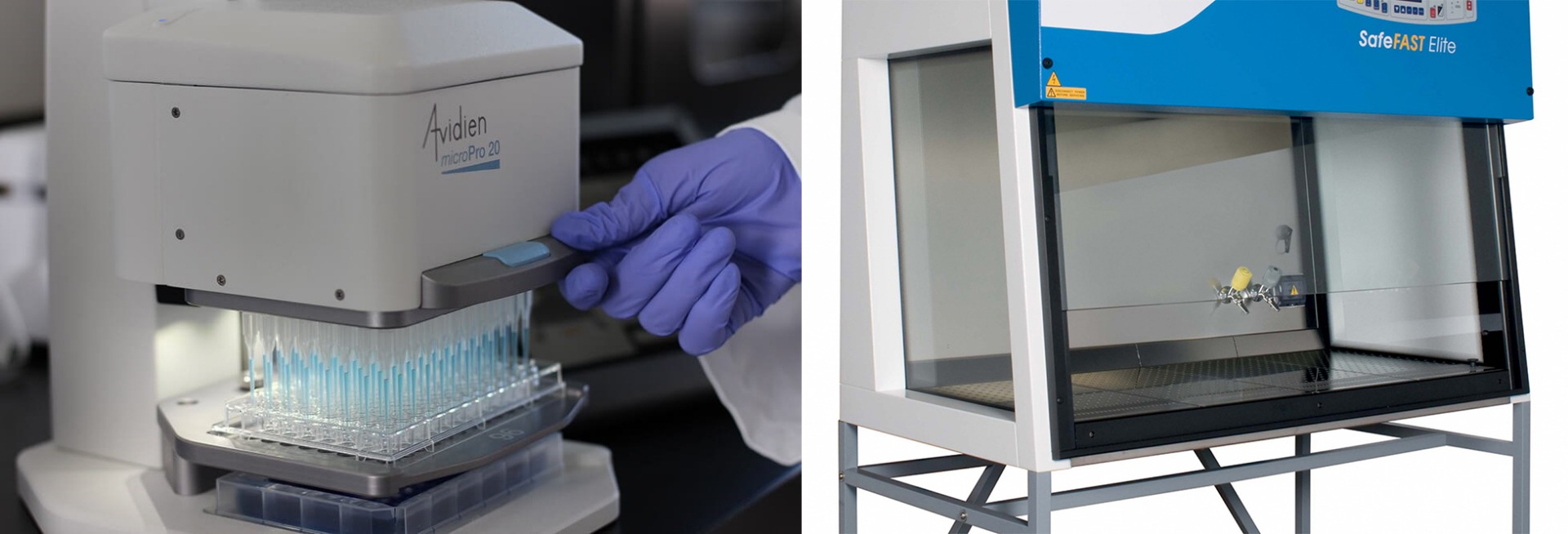Sample contamination is a major concern for molecular biology work. It can create data issues, ruin precious samples, and waste valuable working time. Performing experimental protocols in a biosafety cabinet is an excellent way to help reduce the risk of contamination and help keep laboratory staff safe when working with hazardous reagents or samples.

Thanks to its compact size, portability, and ease of use, the Avidien microPro 96 well pipette, in both 20 and 300 µl volumes, makes it easy to maintain safety cabinet best practices while performing while working in 96 well plates. These tips can help you work efficiently and safely with the microPro in the biosafety cabinet in your laboratory.
Promote Proper Airflow
Standard fume hoods help keep noxious fumes contained by pulling air from outside the hood into the hood and exhausting it out through a vent. While this protects the user and is the best type of hood for working with dangerous gases, it does not provide a sterile environment for your samples.
Safety cabinets go a step further, by filtering both intake and exhaust air through high quality particulate filters. This helps keep the air inside the hood sterile, and prevents particulates and aerosols from exiting the hood.
Consistent and uninterrupted airflow is the key to keeping the air in and out of your safety cabinet clean, contaminant free, and safe for laboratory workers. If airflow is impeded or altered, the inside of the cabinet will not remain sterile. Understanding your cabinet’s airflow, using proper sash height, and keeping grills and vents unobstructed allows for optimal cabinet function.
In most cases, larger instruments and items should be placed near the back of the hood to avoid disturbing airflow near the sash. The microPro is an excellent assistant, even in smaller biosafety cabinets. Its compact footprint makes it an easy fit in tight spaces.
Limit Unnecessary Movement
When working in a safety cabinet, it is important to move slowly and deliberately. Rapid arm movements disrupt the airflow at the front of the cabinet, potentially allowing contaminants to enter or exit. They also increase the likelihood of knocking something over in a small workspace.
Working with the microPro reduces the amount of time a person’s arms need to be in the hood at all. The microPro’s intuitive iPad interface makes it easy to operate the instrument from outside your biosafety cabinet, so operators only need to reach in to change out plates. It allows you to preprogram every step of a protocol to streamline experiments and eliminate the need for manual adjustments when pipetting volumes change between steps.
Work Thoughtfully
Many of the best practices for working in safety cabinets are also best practices for molecular work in general. Using proper pipetting techniques, avoiding splashes and splatter, limiting the amount of time samples are exposed, and keeping sterile items separate from used or contaminated items are all part of good form when working in the laboratory.
The microPro can help with all of the above. With consistent perfect pipetting technique, the microPro helps eliminate common pipetting errors that can cause variation in experimental results. Unexpected drips and splatters are easier to avoid thanks to a wide range of highly customizable settings for tricky liquid types.
The ability to pipette all 96 wells of a plate at once dramatically reduces working time and eliminates the possibility of pipetting to or from the wrong well. This further reduces opportunities for human error, while shortening the amount of time that samples and reagents need to sit uncovered while you work.
With the option to fully input protocols, including non-pipetting steps, the microPro can help users keep track of where they are in an experiment. With shorter worktimes and simpler operation, the microPro frees up focus for good form between pipetting steps, like keeping used tips and plates away from sterile ones.
Go Further in Your Biosafety Cabinet
When safety and sample integrity are critical, a biosafety cabinet helps protect your people and your data. The microPro makes working in 96 wells easier, more efficient, and more convenient, even in the smallest biosafety cabinets.
If you would like to learn more about how the microPro 20 or 300 could support your laboratory efforts, request a free trial to try it in your safety cabinet.

 Deutsch
Deutsch




